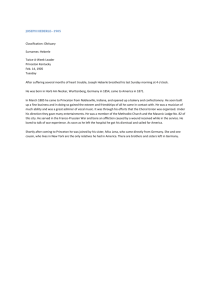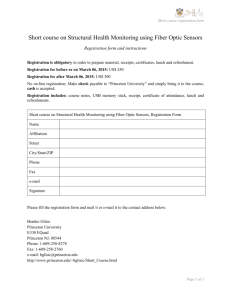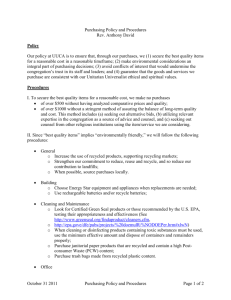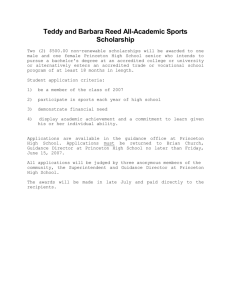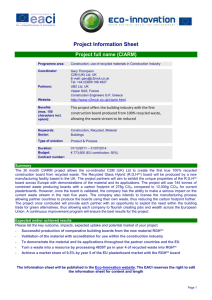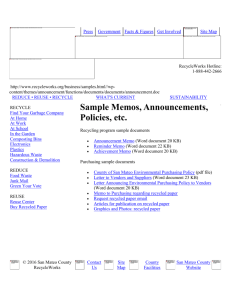Princeton`s Recycled Paper Campaign
advertisement
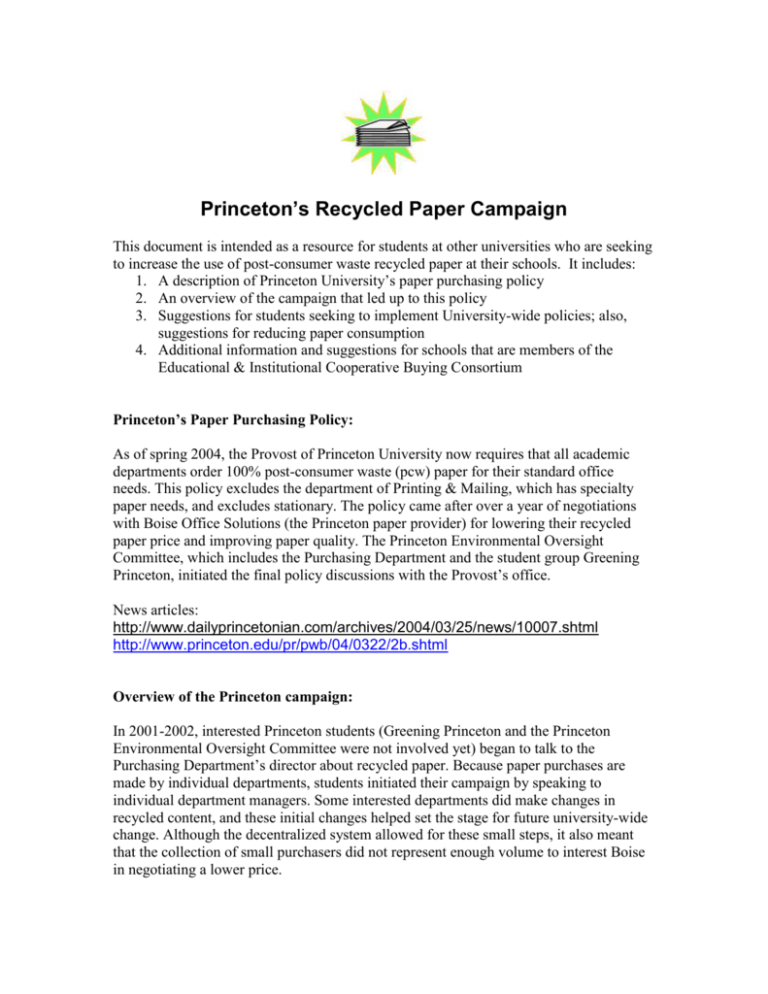
Princeton’s Recycled Paper Campaign This document is intended as a resource for students at other universities who are seeking to increase the use of post-consumer waste recycled paper at their schools. It includes: 1. A description of Princeton University’s paper purchasing policy 2. An overview of the campaign that led up to this policy 3. Suggestions for students seeking to implement University-wide policies; also, suggestions for reducing paper consumption 4. Additional information and suggestions for schools that are members of the Educational & Institutional Cooperative Buying Consortium Princeton’s Paper Purchasing Policy: As of spring 2004, the Provost of Princeton University now requires that all academic departments order 100% post-consumer waste (pcw) paper for their standard office needs. This policy excludes the department of Printing & Mailing, which has specialty paper needs, and excludes stationary. The policy came after over a year of negotiations with Boise Office Solutions (the Princeton paper provider) for lowering their recycled paper price and improving paper quality. The Princeton Environmental Oversight Committee, which includes the Purchasing Department and the student group Greening Princeton, initiated the final policy discussions with the Provost’s office. News articles: http://www.dailyprincetonian.com/archives/2004/03/25/news/10007.shtml http://www.princeton.edu/pr/pwb/04/0322/2b.shtml Overview of the Princeton campaign: In 2001-2002, interested Princeton students (Greening Princeton and the Princeton Environmental Oversight Committee were not involved yet) began to talk to the Purchasing Department’s director about recycled paper. Because paper purchases are made by individual departments, students initiated their campaign by speaking to individual department managers. Some interested departments did make changes in recycled content, and these initial changes helped set the stage for future university-wide change. Although the decentralized system allowed for these small steps, it also meant that the collection of small purchasers did not represent enough volume to interest Boise in negotiating a lower price. Next, students spoke with other administrators about their interest in recycled paper. Two key administrators were the Treasurer and Senior VP of Administration. Collaboration with administrators allowed for the first blind-test of recycled paper in departments. The testing, conducted by Boise Office Solutions, helped dispel misperceptions of recycled paper being inferior quality (98% of departments had no negative reaction) and also identified some paper problems that Boise resolved in a new version of its 100% recycled product. At the same time that administrators became involved in recycled paper at a universitywide level, the Director of Purchasing began negotiations with Boise about reducing its recycled price if every department in the University agreed to switch its copying paper to 100% pcw recycled. To spark department interest in this switch, Boise hosted a “Paper Party” in March 2003 during which it provided lunch to department purchasers and discussed recycled paper options offered by the company. Boise reached an agreement with the Purchasing Department that if all Princeton departments switched to 100% pcw paper the price would come down significantly. This deal, while good for long-term goals, presented the short term problem of getting every department to commit to the change. The Director of Purchasing began discussions with Greening Princeton about strategies for securing an understanding from all departments that, if given the reduced price, they would switch to 100% recycled paper. The Princeton Environmental Oversight Committee (a group of administrators, faculty, and students formed in 2002 to improve environmental practices at Princeton) also became active on the issue at this time. In preparation for presenting the case for recycled paper, Greening Princeton drew up a report of existing Princeton paper practices. The report showed that 60% of paper was entirely virgin. The report also revealed that the largest paper user at the University, which required twice the paper of the next largest purchaser, ordered only 100% pcw paper, discrediting claims that this paper had poor performance and was impossibly expensive. The report also showed that for the median-volume paper purchaser, the highest cost incurred by a switch to 100% pcw would be $110 – meaning that for half of all departments the switch would cost less than the average math textbook. Again, the paper change when re-examined appeared less expensive than originally calculated. Specific details from this report are confidential. The PEOC and Greening Princeton discussed different strategies for achieving the switch to all recycled paper. One option was to have faculty make presentations at departmental meetings on the arguments for a switch. Another was to adjust the software (PeopleSoft) used for placing orders so that the default referred purchasers to 100% recycled. The final option, which was the one chosen, was for the PEOC Chair (who is also the Vice President of Facilities) to present a memo to the Provost requesting a University policy for the change. Simultaneously, Boise brought the prices of 100% recycled and virgin paper even closer to each other, making a change essentially cost neutral. The Chair of the PEOC drafted a memo for the Provost. The PEOC reviewed and approved this memo. Provost accepted the recommendations she received and, with input from the Director of Purchasing, issued a university policy on recycled paper use. Options for Other Schools: Based on our experiences, we would make the following recommendation for students pushing for a University-wide paper policy: Meet with director of Purchasing to determine the ordering system- is it centralized or decentralized? Who is the paper provider, and is the University order potentially high enough that low recycled paper costs can be negotiated? Evaluate current paper purchasing practices. Boise was very helpful in providing purchasing information so that Greening Princeton could write a comprehensive report on paper use – which in several instances was different from what was assumed. For example, many departments were ordering a more expensive virgin paper instead of the less expensive 30% pcw paper (25% of all purchases). Speaking with individual paper purchasers in a decentralized system. Some individuals may be interested in buying recycled. Incentives that Princeton considered: o Recruiting faculty members to present the findings of the paper report, with department-specific statistics, at departmental meetings and advocate for switching to recycled paper. o Contacting those departments that either spent more on paper through using the expensive virgin or those that would have minimal cost increases for the switch to 100% pcw (at least half of all departments) to explore their individual situation and show how they could switch to recycled paper. o Adjusting the PeopleSoft software program used for ordering paper to default to the recycled options and to ask orderers to confirm a virgin order (with ordering numbers for the recycled alternative provided). Reducing Paper Consumption: Princeton has tried the following strategies: Presenting a reduction message first in tabling or brochure efforts around recycling paper. Student environmental groups also have a policy of printing their flyers on the backs of once-used paper. Setting printing cluster printers to default to double-sided printing, and request that department-managed printers do the same. (Note- Princeton does not charge for printing) Asking professors to announce that they prefer to receive their papers printed double-sided. The Educational & Institutional Cooperative Buying Consortium Over 1500 schools are members of E & I Buying Consortium (Educational and Institutional Cooperative) – visit http://www.eandi.org/default.aspx and click on “membership” to find out if your university is a member. Recently this organization signed an agreement with OfficeMax for office supplies and paper. As a result, Aspen 100 (100% PCW recycled) paper is significantly more expensive than virgin paper for members of the Consortium. At Princeton, there is once again a price gap between Aspen 100 and X9 Virgin 84 Bright, the equivalently bright virgin paper of approximately 90 cents per ream. (Other E & I schools may have slightly different prices because service contracts vary.) How do we make 100% PCW paper cheaper? If schools make the commitment that Princeton made, to mandate 100% PCW paper, this will give E & I and OfficeMax the leverage to negotiate lower prices on 100% PCW with Boise or another supplier. According to E & I, the most effective action for students at other schools with tree-free paper campaigns ask their Purchasing people to send letters to E & I saying that they want PCW paper and would be willing to commit to using it if the switch were costneutral (or close) and the quality no different. The person to contact at E & I is Bob Belknap (bbelknap@eandi.org). Even one or two more schools stating a commitment to switch could make the difference! For questions and further information, contact greening@princeton.edu.


